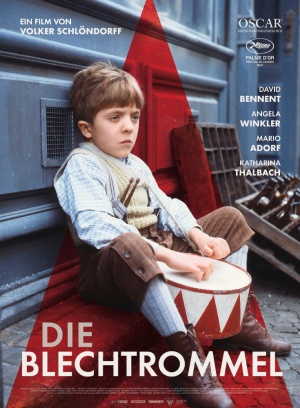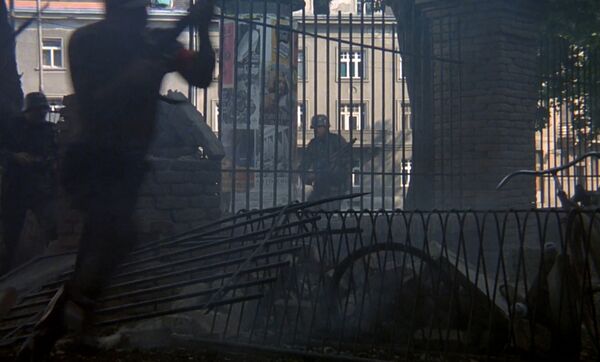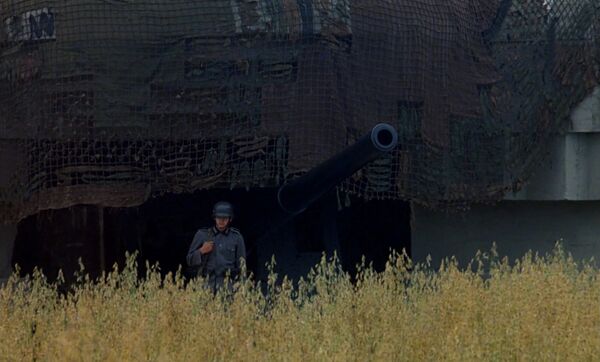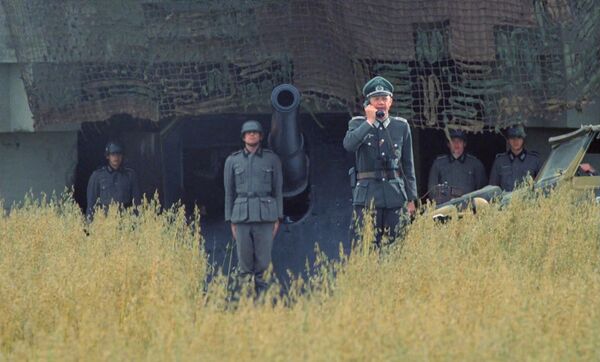The Tin Drum is the 1979 film adaptation of Günter Grass' novel of the same name by Volker Schlöndorff. Free City of Danzig, 1924: A child is born into the Matzerath family. From the moment of his birth, little Oskar is an extremely precocious, quick-witted little boy. Even in his mother's arms, the infant begins to view his surroundings with great skepticism. On his third birthday, Oskar receives a tin drum as a present. On this day, out of a fundamental attitude of rejection, he decides to stop growing by throwing himself down the cellar stairs. He does develop mentally and as a man, but his physical appearance automatically creates a certain distance between Oskar and the world of "adults" from that day onwards. On his pounding tin drum, he articulates his protest against the mendacious, scheming world of adults, which is revealed to him on the one hand in the terror of the Nazis and the other in various sex affairs of his family members.
The film won the Academy Award for Best Foreign Language Film in 1980 at the 52nd Academy Awards and is thus the first German film to receive this award.
The following weapons were used in the film The Tin Drum:
Pistols
Luger P08
A German officer is very briefly seen with a Luger P08 during the surrender of the Polish defenders of the Post Office in Danzig (Gdańsk).
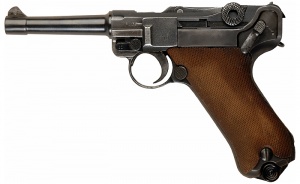
Luger P08 - 9x19mm Parabellum

The Luger is seen right above the shot Jan Michoń who came out of the building shortly before with a white flag; what happened in reality.

The soldier brandishes his Luger.
Rifles
Karabiner 98k
The Karabiner 98k is first seen at the movie's prologue, set in 1899, the Karabiners are anachronistic carried by West Prussian police officers. After that, German soldiers correctly used them during the Second World War.

Karabiner 98k - 7.92x57mm Mauser

Two police officers surround young Anna Koljaiczek (Tina Engel) sitting in a potato field. This Kar98k has a late WWII welded barrel band and S84/98 III bayonet.

The policemen turn around after hearing a suspicious moan.
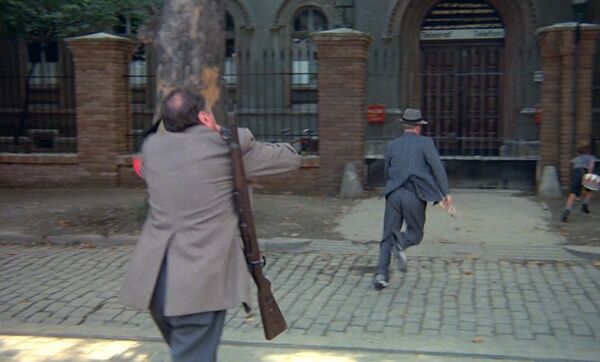
On August 31, 1939, a
Heimwehr member with his carabiner over his back chases Jan making his way into the post office. This Karabiner also has a late war welded barrel band.

A soldier chambers his Karabiner while charging.

Another soldier forces the defenders out of the Post office with his Kar98k.

A soldier and a
Heimwehr member hold their carbines on the right.

A Kar98k is carried by an armed Polish civilian guarding the deportation of German citizens including old Anna Koljaiczek (Berta Drews) from Danzig in 1945. Note the H-style barrel band.
Mannlicher M95M
Jan Bronski (Daniel Olbrychski), Kobyella (Mieczyslaw Czechowicz), and other Polish defenders can be seen using Mannlicher M95M short rifles. These rifles are the Yugoslavian conversion of the Austro-Hungarian M1895.

Mannlicher M95M (M95/24) - 7.92x57mm Mauser

"Proszę, karabin."Jan Michoń hands over a Mannlicher to Jan.

After receiving the rifle and a helmet Jan walks to the ammunition distribution.
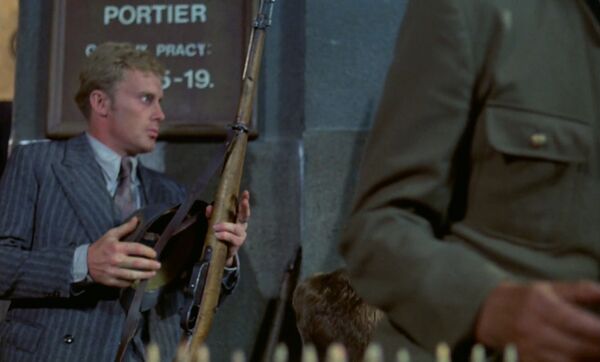
Another view of Jan's rifle shows the magazine which lacks the ejection hole. This a feature of the Yugoslavian M95M which uses stripper clips instead of en-bloc clips.

The tangent-leaf rear sight is visible as he waits for further instructions.
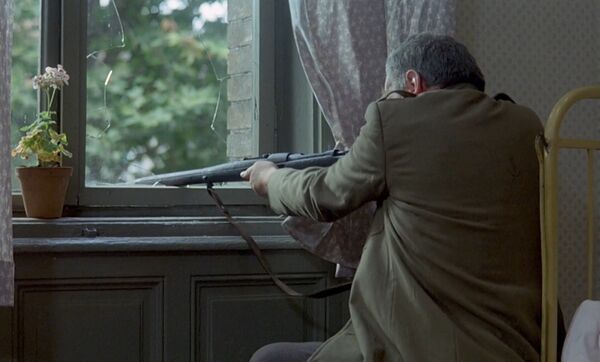
Kobyella works the bolt handle of his Mannlicher.

Lowering the rifle offers a view of the left side.
Mannlicher M1895 Stutzen
At least one of the defenders wields a Mannlicher M95 Karabiner-Stutzen which is most likely a converted 8x56mmR Steyr version.

Karabiner-Stutzen M1895, System Mannlicher - 8x50mmR Mannlicher

The armed man carries the
Karabiner-Stutzen. Note the smooth barrel at the front sight without a ring.
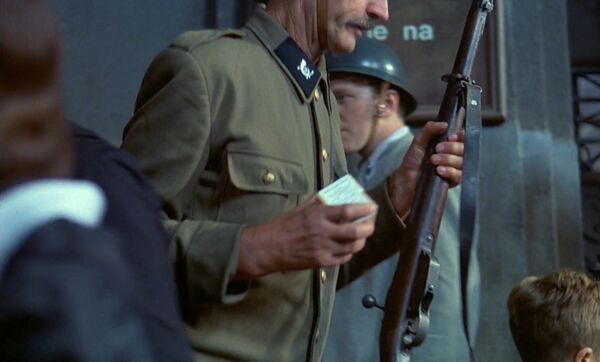
Another view shows the ejection hole. It is equipped with side- and under-mounted sling swivels.

The straight bolt handle is seen.
Steyr Mannlicher M1895/30
Some Polish defenders are armed with Austrian full-length Steyr Mannlicher M1895 rifles and carbines. SS Heimwehr Danzig and Sturmabteilung (SA) members can also seen with this rifle during the surrender of the Polish defenders.

Infanteriegewehr Modell 1895/30, System Mannlicher - 8x56mmR Steyr

Karabiner-Stutzen M1895/30, System Mannlicher - 8x56mmR Steyr
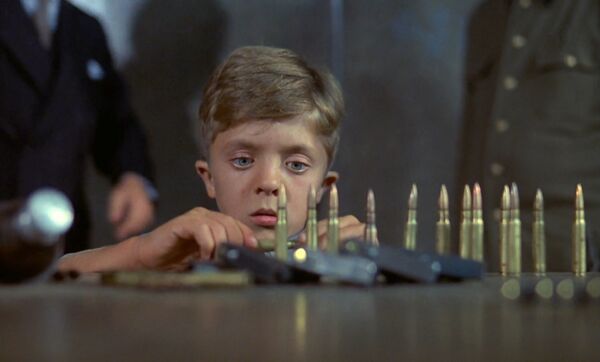
Oskar (
David Bennent) examines an 8x56mmR Steyr round. The en-bloc clips lie in the foreground.

Three Steyr Mannlicher long rifles stacked together.
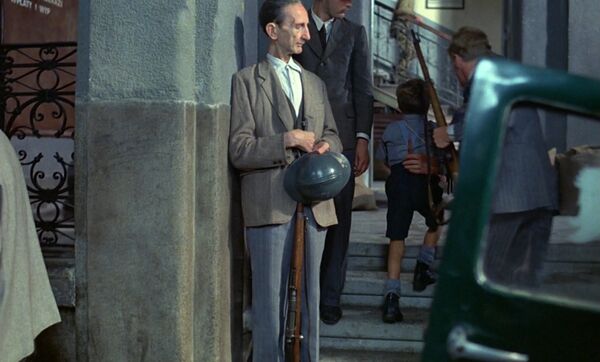
A defender waits with his long rifle which offers a view of the straight pull bolt-action mechanism, receiver, and rear sight.
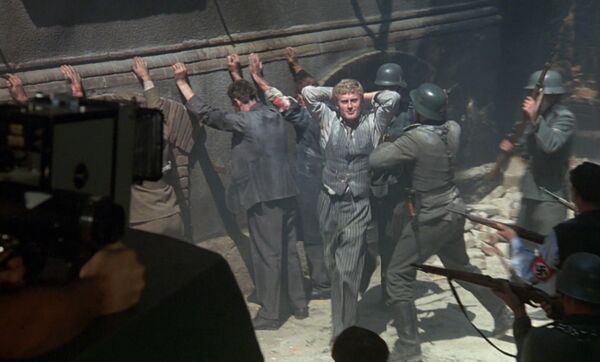
The German soldier on the right aims his Steyr short rifle at the lined up prisoners outside the post office.
Mauser Rifle
Two unknown Mauser rifles are briefly seen held by a German soldier in 1914 and a Hitlerjugend boy.

The soldier stands guard at the entrance to the Danzig barracks. The Mauser appears to have a flat tangent sight. It is also worth mentioning that this soldier wears an anachronistic
Stahlhelm M16 which was only introduced two years later. He should have a
Pichelhaube instead.

The rifle is seen on the right shouldered by the boy. It has a straight bolt handle.
Submachine Guns
PPSh-41
Soviet Soldiers at the end are armed with PPSh-41 submachine guns.

PPSh-41 - 7.62x25mm Tokarev
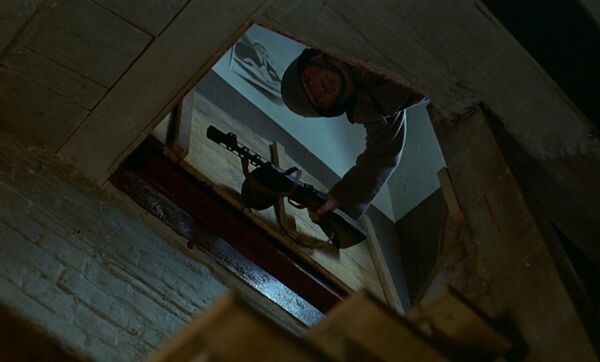
"Hände hoch!"A Soviet soldier with his PPSh opens the cellar door.

A Polish soldier stands guard with his slung PPSh.
KP m/44
Some Finnish Tikkakoski m/44s, a copy of the PPS-43, with drum magazines are also used by Red Army soldiers.

Tikkakoski M/44 - 9x19mm Parabellum. The M/44 magazines are interchangeable with the
Suomi KP/-31 box and drum magazines.

Soviet soldiers carrying KP m/44s enter the cellar and go straight to Lina Greff (Andréa Ferréol).
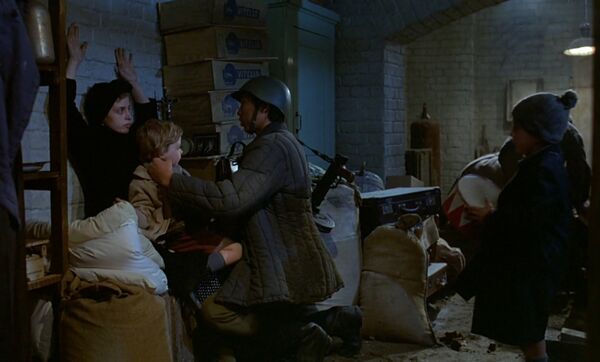
A Russian kneels in front of Maria (Katharina Thalbach) and Kurt. The pistol grip is seen.
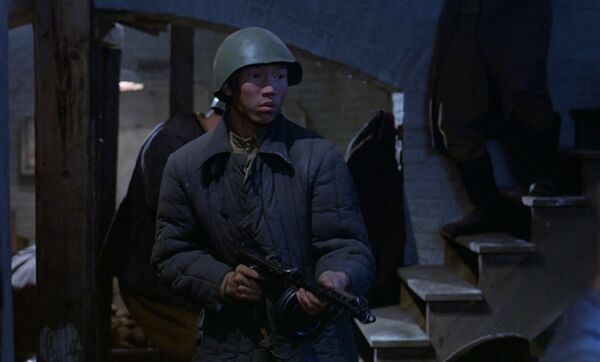
The same soldier points his gun at Alfred Matzerath (
Mario Adorf).
Machine Guns
MG 42
The MG42 is first seen during the beginning of World War Two in 1939 and later on bunkers of the Atlantikwall.
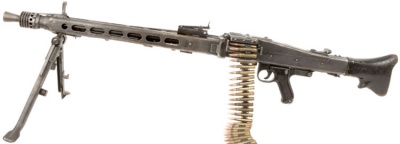
Maschinengewehr 42 - 7.92x57mm Mauser
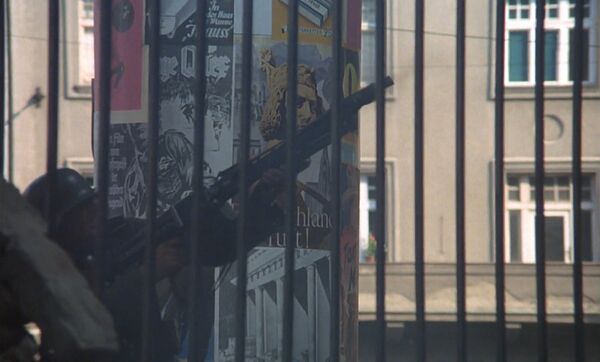
An SS soldier fires his MG42 at the Post office in 1939.
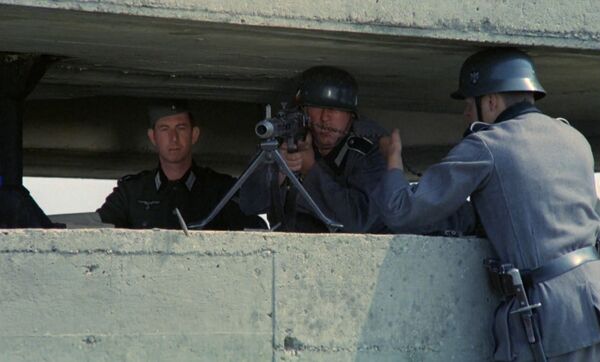
Another MG42 being fired from a Bunker.
Browning M1919A6
Three Browning M1919A6 are seen during the Atlantikwall scenes.

Post-WWII manufacture Browning M1919A6 - .30-06 Springfield
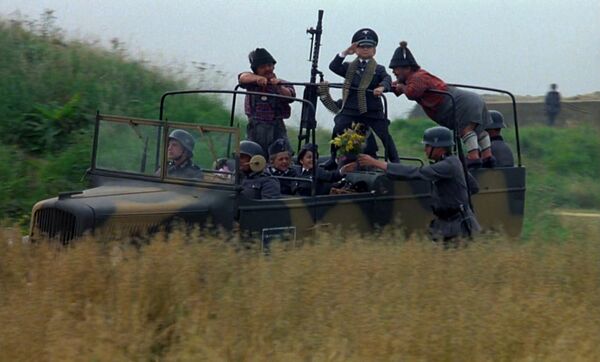
A mounted Browning on the Opel Blitz truck.
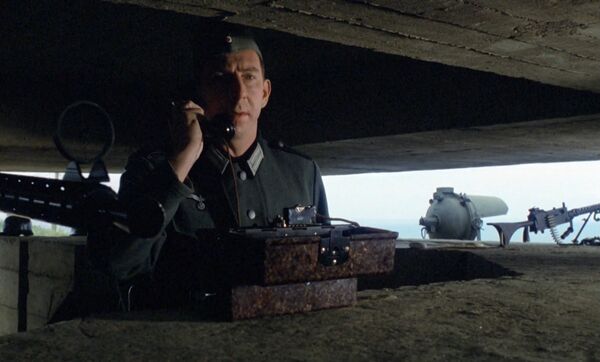
Two other Brownings seen in a bunker next to
Obergefreiter (Corporal) Lankes (Bruno Thost).
Other
Armored Car
During the post office siege, American White M3 Scout Cars were mocked up to resemble Austrian Steyr ADGZs which were actually used by the German attackers.

SS soldiers take cover behind the armored car.
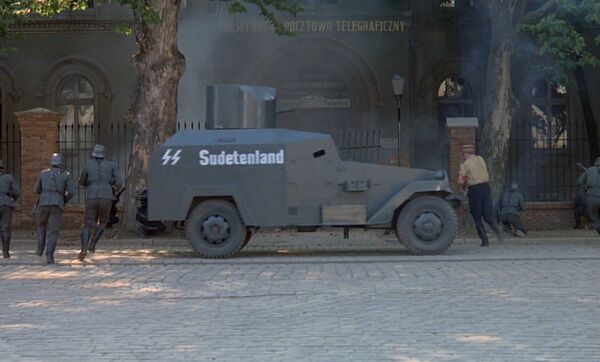
The
Sudentenland drives by the main entrance. The other two were labeled
Ostmark and
Saar.
10.5-cm-leichte Feldhaubitze 18/40
A 10.5 cm leichte FeldHaubitze 18/40 standing in for the historically correct predecessor is deployed by the attackers of the Post Office. Two 7.5 cm le.IG 18 infantry support guns were also used by the Waffen SS but are not depicted in the movie.
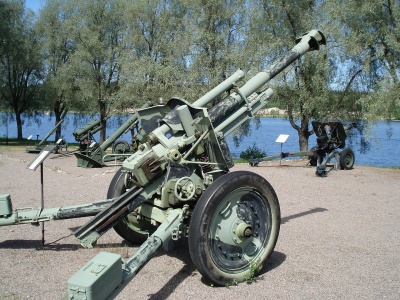
Leichte Feldhaubitze 18/40 - 105mm
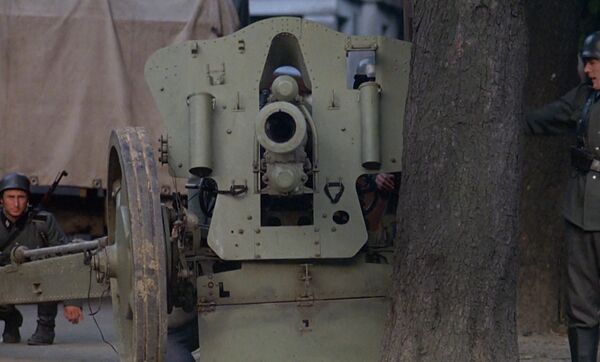
The prepared
Feldhaubitze ready to fire at the post office. The left gun crewmember's Kar98k is equipped with a hooded front sight; this was only added to the carbines from 1941 onwards.
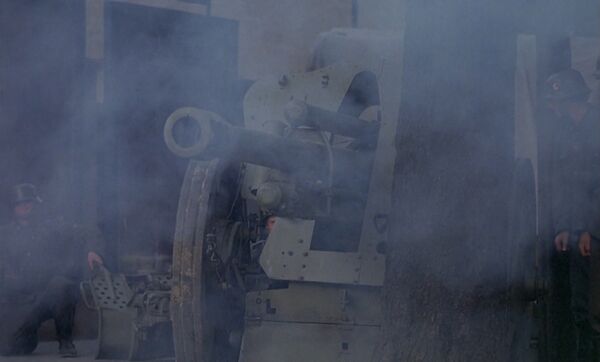
Another view of the howitzer after firing.
Model 24 Stielhandgranate
One of the SS soldiers uses a Model 24 Stielhandgranate.

Stielhandgranate Modell 24

Two views of the soldier on the left preparing his Stielhandgranate.
Flamethrower
Two German soldiers can be seen with unknown flamethrowers.
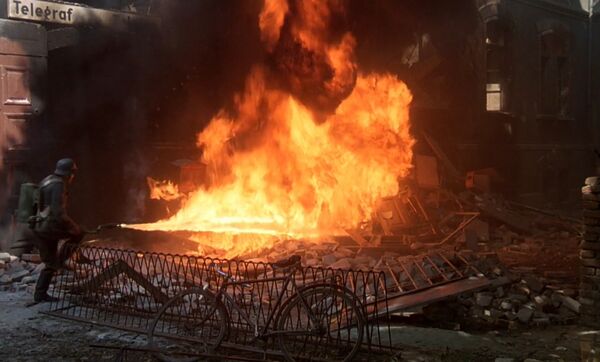
The first soldier lays down flame.
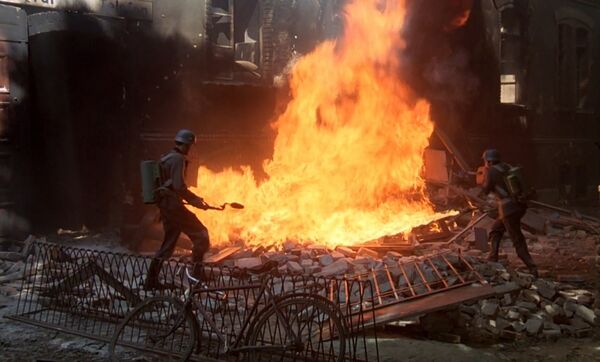
The second flamethrower is seen. In fact, flamethrowers were used during the siege, infamously to burn surrendering Józef Wąsik alive. This incident is not present in the movie.
15 cm TbtsK C/36 naval gun
The 15 cm TbtsK C/36 is seen mounted in a bunker.
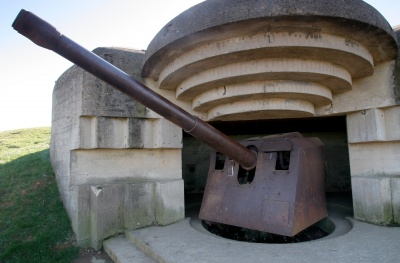
15 cm TbtsK C/36 naval gun in a
Regelbau M272 casemate at the Longues-sur-Mer battery, France.



